Interview by Arielle Bier in Berlin; Monday, Aug. 31, 2015
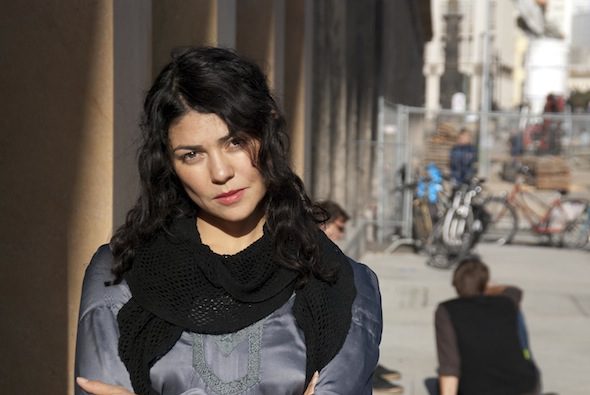 Julieta Aranda – Portrait; Courtesy of the e-flux
Julieta Aranda – Portrait; Courtesy of the e-flux
Over the last seventeen years, e-flux became the ‘go-to’ platform for information and exchanges between art and academia worldwide with a readership of 90,000+ visual arts professionals. Russian artist Anton Vidokle initially conceived the project as a mailing-list for promoting exhibitions during the early days of email. The need for harnessing the power of the internet as a networking tool to share text and images related to art events quickly evolved and escalated. In 2003, Vidokle joined forces with fellow cultural producer and conceptually driven artist Julieta Aranda, who helped establish the first e-flux project space in New York City, and expand the independent enterprise with her interest in radical ideas about circulation and exchange influenced by anthropologist Elizabeth Povinelli.
As collaborators, Vidokle and Aranda developed the multi-faceted organization to function as a publishing platform, archive, artist project, and curatorial platform, working with numerous artists such as Rob Pruitt, Boris Groys and Hito Steyerl, curators like Monika Szewczyk, Molly Nesbit and Jens Hoffmann, and theorists including Bruno Latour, Franco “Bifo” Berardi and Keller Easterling. Their strong focus on open source systems and making knowledge available to the public brought about the web projects art-agenda and art&education, and can be seen in projects such as DO IT, the webzine and online curatorial project by Hans Ulrich Obrist, while compiled ‘do it yourself’ instructions for art projects or Martha Rosler’s Library, which made the 7600 books in artist Martha Rosler’s home and studio libraries available to the public.
Along with editor Brian Kuan Wood, who joined the e-flux journal team in 2008, Vidokle and Aranda have commissioned, co-edited and contributed to prescient books such as Are You Working Too Much? Post-Fordism, Precarity, and the Labor of Art (2011) and The Internet Does Not Exist (2015), bringing together great minds and discourse at the forefront of cultural change.
e-flux was developed in parallel to both Vidokle and Aranda’s solo artistic practices, but has also allowed them to collaborate widely on art projects that have exhibited in international biennials, museums and galleries. I met with artist and e-flux collaborator Julieta Aranda in a flurry of activity to find out more about their collaborative projects and history, and the concepts behind what drives e-flux forward.
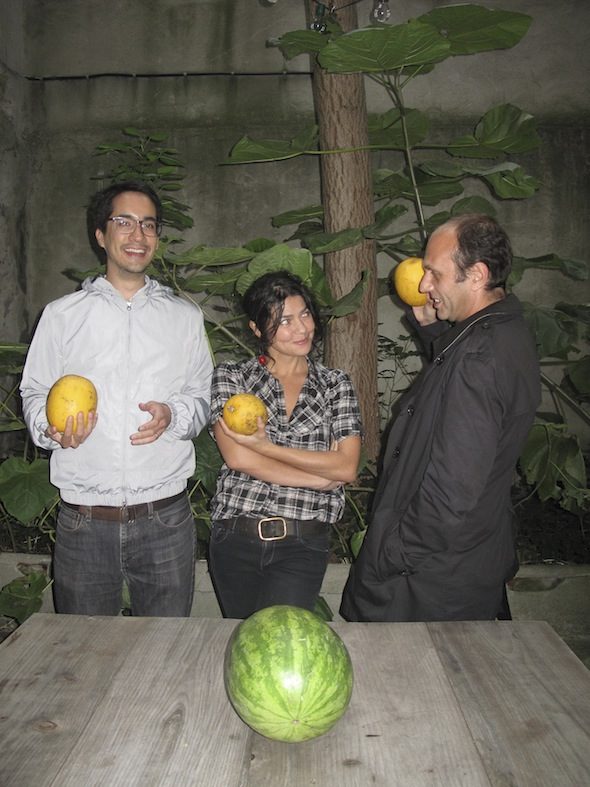 Brian Kuan-Wood, Julieta Aranda, Anton Vidokle; Photo by Mila Zacharias, courtesy of e-flux
Brian Kuan-Wood, Julieta Aranda, Anton Vidokle; Photo by Mila Zacharias, courtesy of e-flux
Arielle Bier: How did you first meet Anton and get involved with e-flux?
Julieta Aranda: We met entirely randomly smoking a cigarette outside a party in New York. I was working as a film editor at HBO, and he was just starting e-flux. Eventually, we became friends. We were a couple, which is not necessarily part of the story, but it happened. At the time, it was a very small laptop and him. We were spending so much time together. The beginning was focused on developing the newsletter. E-flux came out of a public event, which was a big one-night exhibition called The Best Surprise is No Surprise at the Holiday Inn in Chinatown. I wasn’t around yet. Because it was disseminated by email, Anton thought ‘Oh, maybe this email thing is something’. That was the seed of e-flux.
Simultaneously, we were sharing a studio in Tribeca, which was a horrendous place. It was this fifth floor walk up with no elevator, and had these stairs that were designed by really cruel architects that were painful to climb. The lease was up at some point, so we decided to take another space – a ground floor, with no stairs at all! It soon stopped being an artist studio and became more of a working place. E-flux was spiralling larger. Since both of us are artists, it was very natural that we started to develop projects that were definitively not commercial ventures, – but they also weren’t conventional artworks or exhibitions. The first of these projects was e-flux video rental.
AB: Were you doing actual rentals?
JA: It was based on a Mom and Pop video store. All the good video stores in the neighborhood like Kim’s Video started to die. There was a moment when, if you were an artist and you were working with video (and that was my case), you had two VHS tapes because you were constantly making dubs. That’s how you circulated your work. There was no Internet video, no YouTube, no file-transfer systems. It was based on this idea of how to navigate your way through piles of VHS tapes, how you encountered work, and so on. It had a lot to do with organization. The video shop was free of charge. It was very much an art project. The films came from artists and curators we asked to help us select material and contact the artists. We explained that it had more to do with examining modes of circulation of the moving image than with being an arbiter of taste and figuring out what needs to be archived. We ended up with something like a thousand works in the collection.
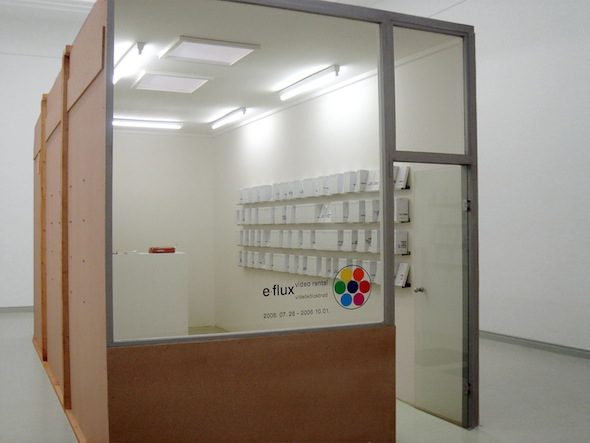 E-flux Video Rental (2006), Mucsarnok/Kunsthalle, Budapest; Courtesy of the e-flux
E-flux Video Rental (2006), Mucsarnok/Kunsthalle, Budapest; Courtesy of the e-flux
AB: Where are all of these tapes now?
JA: We made three editions of the work. The last time we showed it was two years ago and then it was donated as a permanent installation to the Moderna Galerija in Ljubljana.
Then there was the PAWNSHOP which a very direct response to the financial and housing crisis in New York. We turned the same storefront space into a pawnshop for artists. We gave a fixed loan of 99.99 dollars to anybody that would come to pawn a work. If they didn’t retrieve the work within a month, then the work would be put up for sale at market value. We made a lot of these projects that had a real foothold on reality.
After that came Time/Bank. In New York, we had a Time/Store where it was possible to do transactions based on time. Here we were running a Time/Food restaurant at my studio. There was a moment around the time when we presented the work at dOCUMENTA (13) when there were several branches active all over the world. It was so nice when somebody would show up at the Time/Food restaurant with a Time/Currency stamped from Brussels for example. You could see this circulation of time, this circulation of effort. That was really nice.
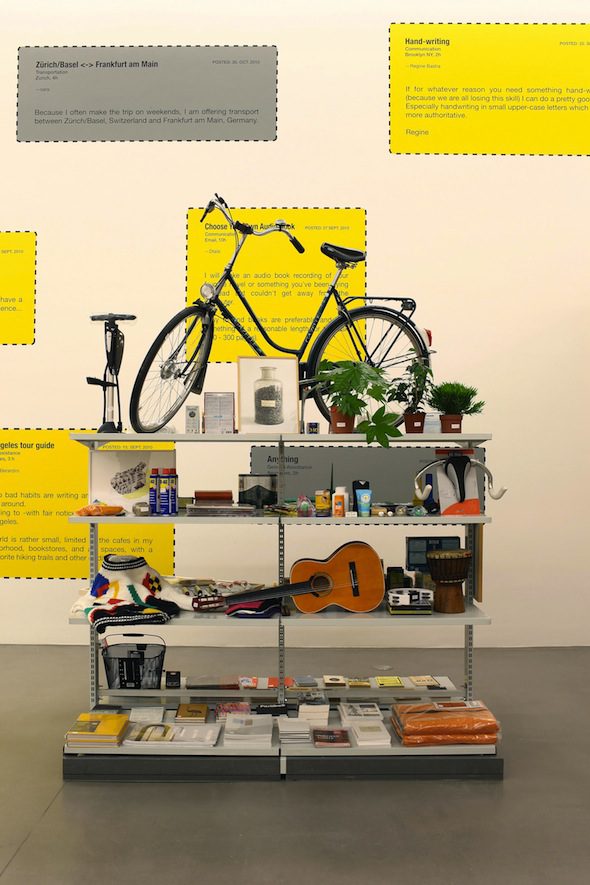 Time/Bank, Portikus, Frankfurt am Main, (2011) ; Photo by Helena Schlichting, courtesy of Portikus
Time/Bank, Portikus, Frankfurt am Main, (2011) ; Photo by Helena Schlichting, courtesy of Portikus
AB: How do you come up with ideas and choose which projects to take on?
JA: Anton and I have a very fluid communication channel and a good way to catch on to each other’s ideas and realize them. We have been working together for almost fifteen years. I know when to shoot down an idea of his, and he knows when to shoot down an idea of mine. When we were invited to do a project for the current Venice Biennial, we sat doodling in a café, trying to figure out how we can turn this invitation into something that makes sense for us. In an hour and a half we came up with this Supercommunity thing. Instead of doing monthly publishing, we have been doing daily publishing, five times a week of shorter texts that are a bit more urgent and not as academic as the texts that we usually work with on e-flux journal. At the end of the day, Anton and I are artists. We wanted to see additional formats. This was a chance to experiment with bringing in poetry and fiction.
AB: How did you start taking on other team members? What was the expansion process like?
JA: Now it is a pretty complex structure, but it didn’t start like that. If I had to think of e-flux and what it is now, it would have been impossible. How do you get from zero to all this? Publishing online and physically, running projects and having a space while working bi-continentally. That would have been a really scary, steep ladder. Instead it has been a very organic process of people coming in and out as ideas develop. Something comes up, so we find someone dedicated to that single element. When it comes to Anton and me, we have our hands in every single aspect of e-flux.
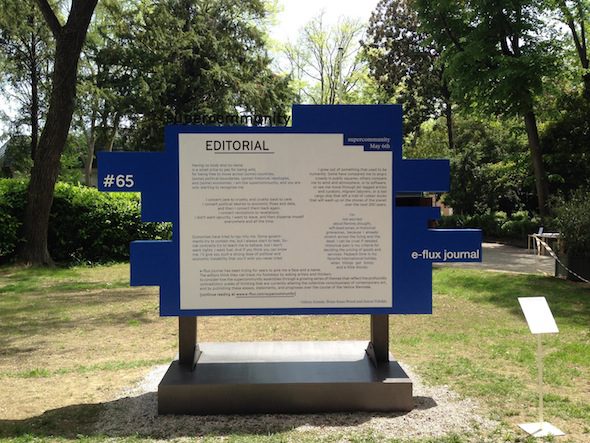 Supercommunity, Venice Biennale 2015; Courtesy of the e-flux
Supercommunity, Venice Biennale 2015; Courtesy of the e-flux
AB: The way you talk about e-flux, it’s as if it is a small group. You have 90,000 subscribers now. Realizing the strength and influence your voice can have on so many people is very powerful.
JA: I try not to think about that too much to be honest. It’s a bit frightening. I mean, it’s great and I wouldn’t change any of it. But if I start to ask, how do I make 90,000 people happy? How do I listen to 90,000 people? I cannot think like that. A lot of the strength of our projects came from the fact that they were not intended as representational platforms. Whatever is at the beginning of the projects, conversation, or curiosity is really genuine and honest.
With the journal for example, what is the most exciting for me, is that I am not in a place where I wait and see what ideas are out there so that I can incorporate them into my practice. I’m not an academic or a theoretician, or a formally trained writer, but I know the fields, and I can then commission texts about a lot of things that arouse my curiosity. This is a very active position, and what I enjoy the most. Then, of course it becomes an available open resource for whoever accesses it because of it’s free circulation.
AB: Why free-circulation? Why did you choose to make this type of non-commercial platform?
JA: From the very beginning, circulation was super important for the two of us, discussing how information moves, how academic journals move. Part of what happens to the journal is very much a response to things like JSTOR and the ‘pay wall of knowledge’ where you can only access certain things if you have the means. I come from Mexico City, Anton comes from Moscow, we were both not in the center of things, not in the right place at the right time as we were growing up. I have a very direct sense of what it’s like not to have things available to you. It’s the same on on his side.
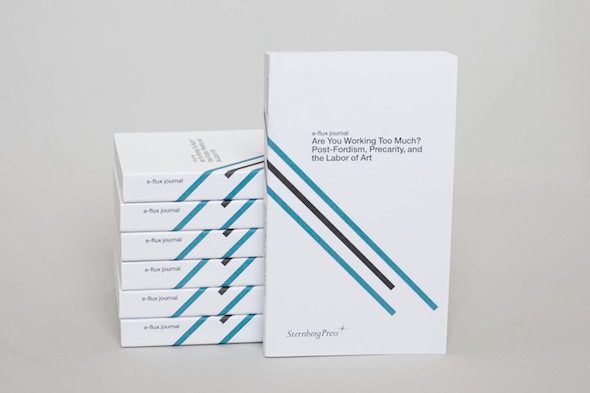 Are You Working Too Much?, e-flux journal; Courtesy of e-flux
Are You Working Too Much?, e-flux journal; Courtesy of e-flux
AB: Did you realize that you were harnessing the power of the Internet at the time, or was it simply just a new tool available?
JA: When we started e-flux, the internet was not so hot for art. Net people and net art was not fantastic. It wasn’t evident that it would last. It’s very different to do something that immediately echoes. If we were doing it now, it would be very easy to know what it means. But when we started, it was more about trusting our curiosity and finding all this potential in it.
AB: Since the beginning, you’ve always had a physical space in addition to the online presence. Is this an essential element?
JA: I pushed very much for the physical space. I don’t want e-flux to be something where you can just disconnect the electricity and poof! there it goes, like turning off the light. I like to see the books. I like to see the journals. I like to inhabit both instances in the world. I don’t see why we should choose one or the other.
___________________________________________________________________________________























